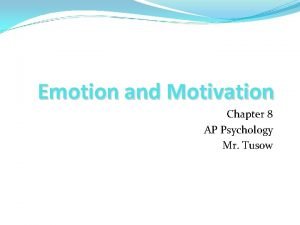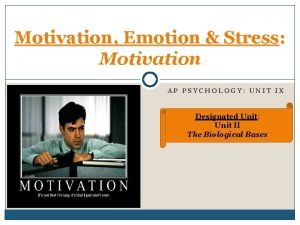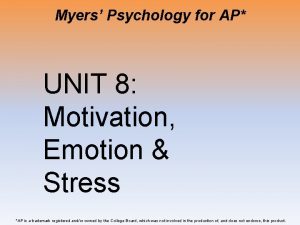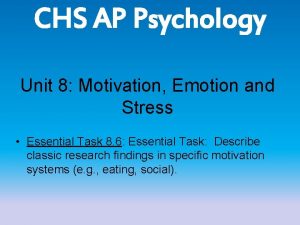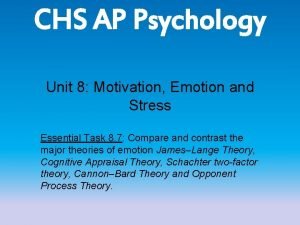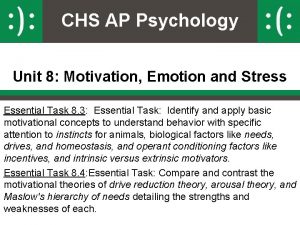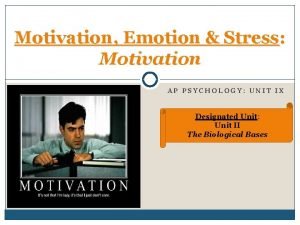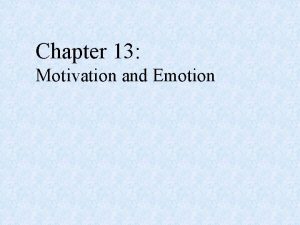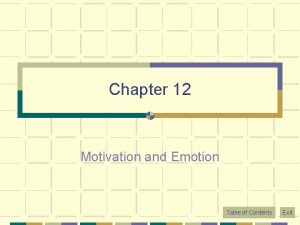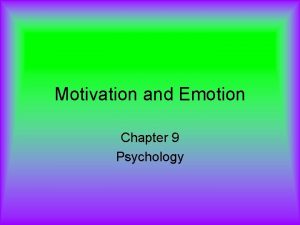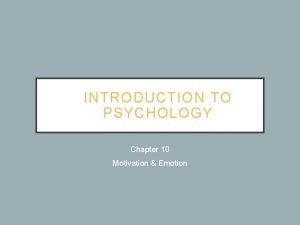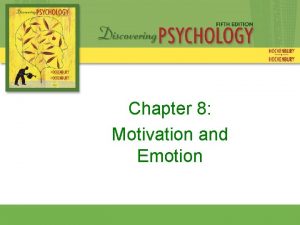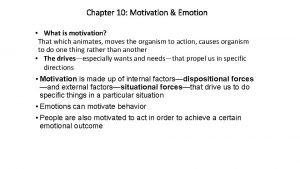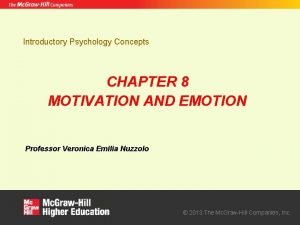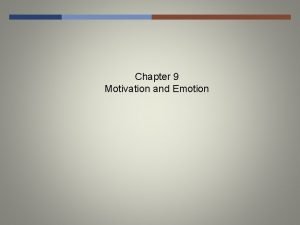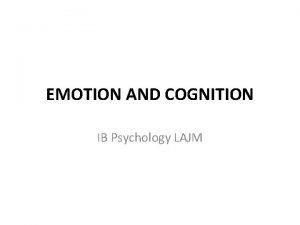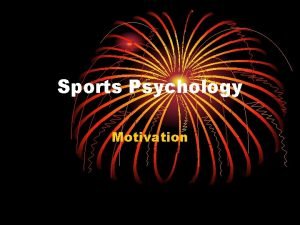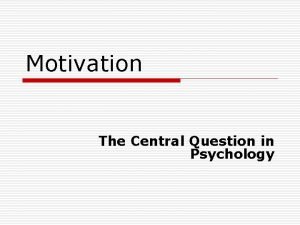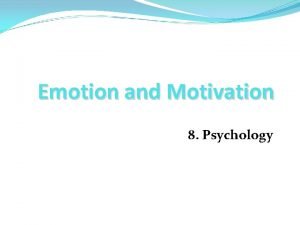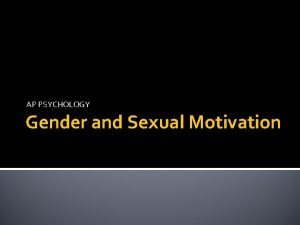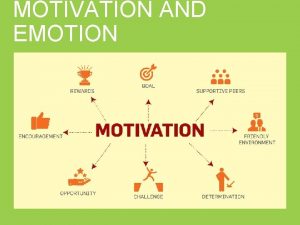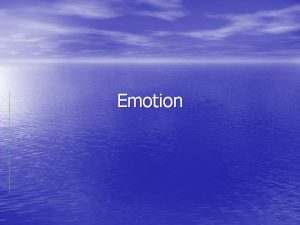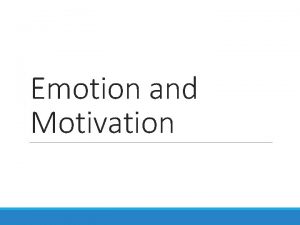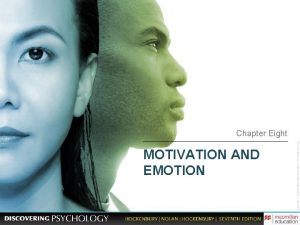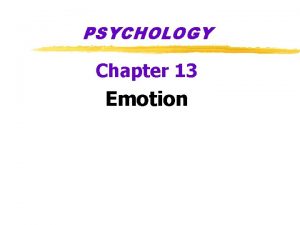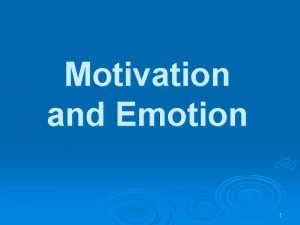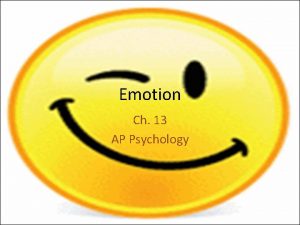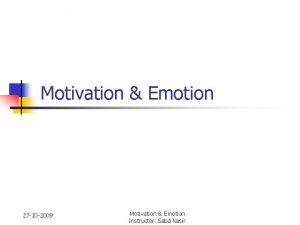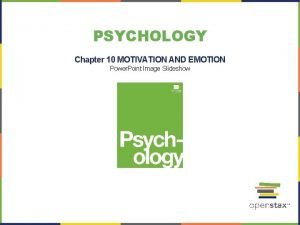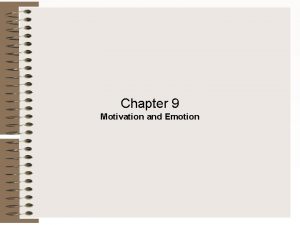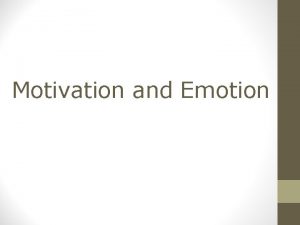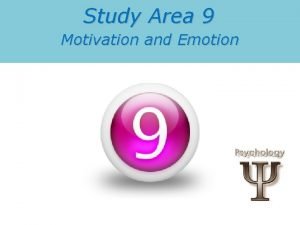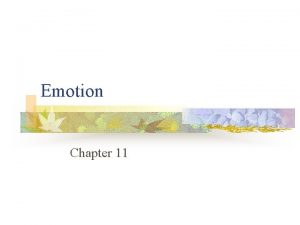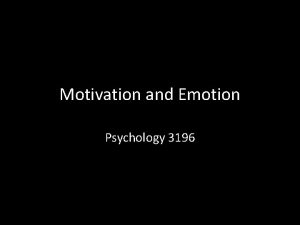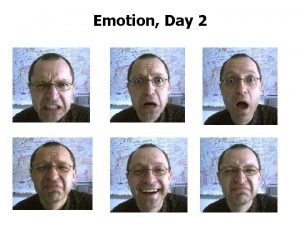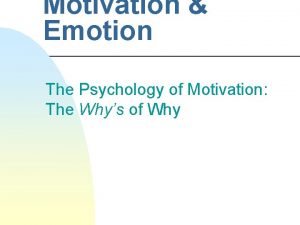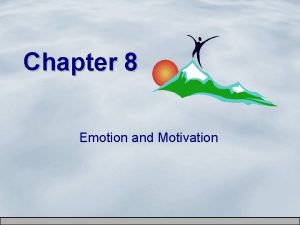PSYCHOLOGY Chapter 10 MOTIVATION AND EMOTION Power Point


























- Slides: 26

PSYCHOLOGY Chapter 10 MOTIVATION AND EMOTION Power. Point Image Slideshow

FIGURE 10. 1 Emotions can change in an instant, especially in response to an unexpected event. Surprise, fear, anger, and sadness are some immediate emotions that people experienced in the aftermath of the April 15, 2013 Boston Marathon bombing. What are emotions? What causes them? What motivated some bystanders to immediately help others, while other people ran for safety? (credit: modification of work by Aaron “tango” Tang)

FIGURE 10. 2 Intrinsic motivation comes from within the individual, while extrinsic motivation comes from outside the individual.

FIGURE 10. 3 Research suggests that when something we love to do, like icing cakes, becomes our job, our intrinsic and extrinsic motivations to do it may change. (credit: Agustín Ruiz)

FIGURE 10. 4 (a) William James proposed the instinct theory of motivation, asserting that behavior is driven by instincts. (b) In humans, instincts may include behaviors such as an infant’s rooting for a nipple and sucking. (credit b: modification of work by “Mothering Touch”/Flickr)

FIGURE 10. 5 Hunger and subsequent eating are the result of complex physiological processes that maintain homeostasis. (credit “left”: modification of work by “Gracie and Viv”/Flickr; credit “center”: modification of work by Steven Depolo; credit “right”: modification of work by Monica Renata)

FIGURE 10. 6 The concept of optimal arousal in relation to performance on a task is depicted here. Performance is maximized at the optimal level of arousal, and it tapers off during underand overarousal.

FIGURE 10. 7 Task performance is best when arousal levels are in a middle range, with difficult tasks best performed under lower levels of arousal and simple tasks best performed under higher levels of arousal.

FIGURE 10. 8 Maslow’s hierarchy of needs is illustrated here. In some versions of the pyramid, cognitive and aesthetic needs are also included between esteem and selfactualization. Others include another tier at the top of the pyramid for selftranscendence.

FIGURE 10. 9 Hunger and eating are regulated by a complex interplay of hunger and satiety signals that are integrated in the brain.

FIGURE 10. 10 This chart shows how adult BMI is calculated. Individuals find their height on the y-axis and their weight on the x-axis to determine their BMI.

FIGURE 10. 11 Gastric banding surgery creates a small pouch of stomach, reducing the size of the stomach that can be used for digestion.

FIGURE 10. 12 Eugenia Martínez Vallejo, depicted in this 1680 painting, may have had Prader-Willi syndrome. At just eight years old, she weighed approximately 120 pounds, and she was nicknamed “La Monstrua” (the monster).

FIGURE 10. 13 Young women in our society are inundated with images of extremely thin models (sometimes accurately depicted and sometimes digitally altered to make them look even thinner). These images may contribute to eating disorders. (credit: Peter Duhon)

FIGURE 10. 14 A male rat that cannot engage in sexual behavior still seeks receptive females, suggesting that the ability to engage in sexual behavior and the motivation to do so are mediated by different systems in the brain. (credit: Jason Snyder)

FIGURE 10. 15 The medial preoptic area, an area of the hypothalamus, is involved in the ability to engage in sexual behavior, but it does not affect sexual motivation. In contrast, the amygdala and nucleus accumbens are involved in motivation for sexual behavior, but they do not affect the ability to engage in it.

FIGURE 10. 16 In 1947, Alfred Kinsey established The Kinsey Institute for Research, Sex, Gender and Reproduction at Indiana University, shown here in 2011. The Kinsey Institute has continued as a research site of important psychological studies for decades.

FIGURE 10. 17 This graph illustrates the different phases of the sexual response cycle as described by Masters and Johnson.

FIGURE 10. 18 Between 3% and 10% of the adult population identifies as homosexual. (credit: Till Krech)

FIGURE 10. 19 Chaz Bono, a transgender male, is a well-known person who transitioned from female to male. (a) In the 1970 s, the world knew Chaz as Chastity Bono, the daughter of the famous entertaining duo Sonny and Cher; here young Chastity is pictured with Sonny. (b) Later in life, Chaz transitioned to align his physical body with his gender identity. (credit b: modification of work by “dvsross”/Flickr)

FIGURE 10. 20 Toddlers can cycle through emotions quickly, being (a) extremely happy one moment and (b) extremely sad the next. (credit a: modification of work by Kerry Ceszyk; credit b: modification of work by Kerry Ceszyk)

FIGURE 10. 21 This figure illustrates the major assertions of the James-Lange, Cannon. Bard, and Schachter-Singer two-factor theories of emotion. (credit “snake”: modification of work by “tableatny”/Flickr; credit “face”: modification of work by Cory Zanker)

FIGURE 10. 22 The limbic system, which includes the hypothalamus, amygdala, and the hippocampus, is involved in mediating emotional response and memory.

FIGURE 10. 23 The anatomy of the basolateral complex and central nucleus of the amygdala are illustrated in this diagram.

FIGURE 10. 24 The seven universal facial expressions of emotion are shown. (credit: modification of work by Cory Zanker)

This Power. Point file is copyright 2014 -2015, Rice University. All Rights Reserved.
 Over justification affect
Over justification affect Psychology chapter 9 motivation and emotion
Psychology chapter 9 motivation and emotion Hormones ap psychology
Hormones ap psychology Myers psychology unit 8
Myers psychology unit 8 Unit 8 motivation emotion and stress
Unit 8 motivation emotion and stress Two factor theory psychology
Two factor theory psychology Homeostasis definition ap psychology
Homeostasis definition ap psychology Ap psychology unit 8 motivation emotion and stress
Ap psychology unit 8 motivation emotion and stress Chapter 13 motivation and emotion
Chapter 13 motivation and emotion Chapter 12 motivation and emotion
Chapter 12 motivation and emotion Carroll izard 10 basic emotions
Carroll izard 10 basic emotions Paul ekman universal facial expressions
Paul ekman universal facial expressions Chapter 8 motivation and emotion
Chapter 8 motivation and emotion Chapter 10 motivation and emotion
Chapter 10 motivation and emotion Chapter 8 motivation and emotion
Chapter 8 motivation and emotion Chapter 9 motivation and emotion
Chapter 9 motivation and emotion What motivates you
What motivates you Teacup ib psychology
Teacup ib psychology Ac power formula
Ac power formula Power bi training powerpoint
Power bi training powerpoint Point point power
Point point power To a social psychologist a perceived incompatibility
To a social psychologist a perceived incompatibility Motivation psychology definition
Motivation psychology definition Psychology types of motivation
Psychology types of motivation Drive reduction
Drive reduction Ap psychology sexual motivation
Ap psychology sexual motivation Sexual motivation ap psychology
Sexual motivation ap psychology
